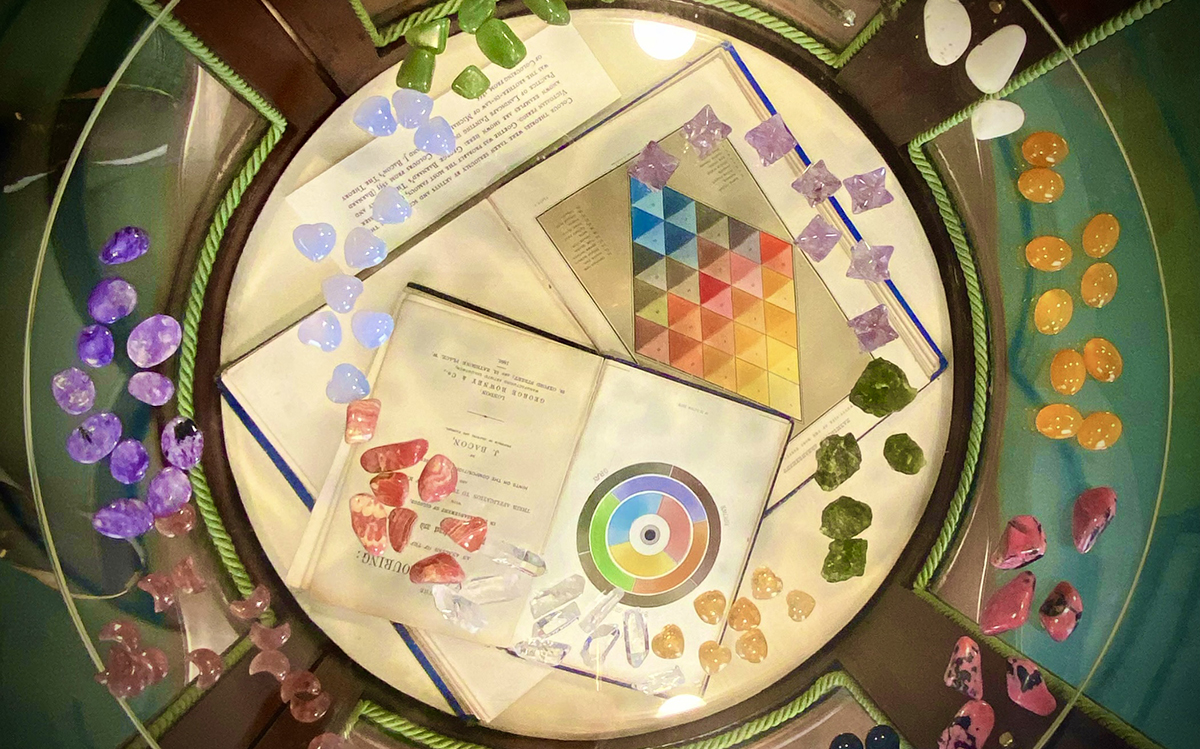
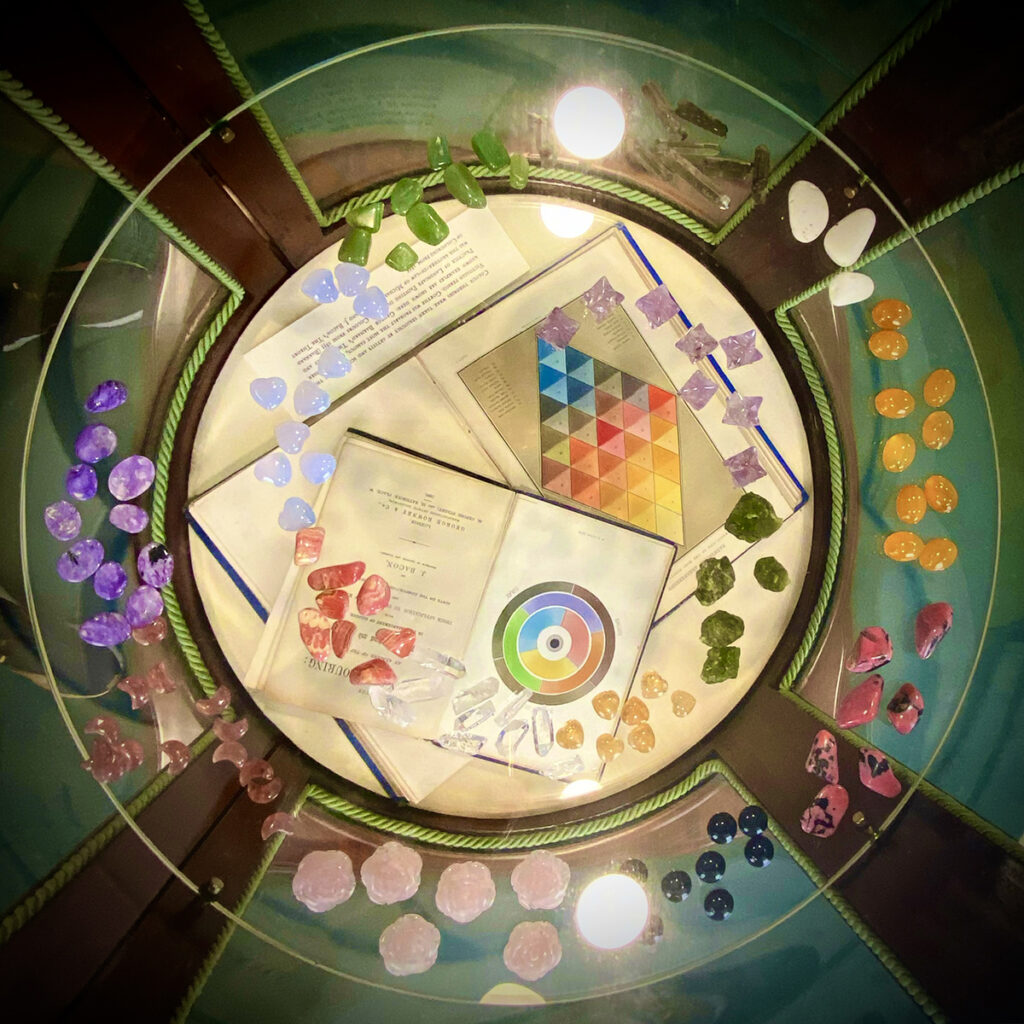
LONDON’S COLLEGE OF PSYCHIC STUDIES “REDIALS THE SPECTRUM”
Taking a break from a table-rattling séance, brutjournal’s London-based correspondent, the artist Cathy Ward, headed out to visit Vivienne Roberts, the archivist and curator, and Gillian Matini, the college principal, at the College of Psychic Studies, an institution that grew out of the London Spiritualist Alliance in the late 19th century and is still in operation today.
The College’s website notes that the Alliance “was formed by the Rev. William Stainton Moses in 1884 to meet the Victorian era’s rising interest in Spiritualism and psychic phenomena.” That organization “acquired its current London premises, a beautiful townhouse in South Kensington, in 1925, under the presidency of Sir Arthur Conan Doyle [the British writer and physician who created the fictional character Sherlock Holmes].”
Cathy Ward reports:
“Light reveals the glories of the external world and yet is the most glorious of them all. It gives beauty, reveals beauty and is itself most beautiful. It is the analyser, the truth-teller and the exposer of shams, for it shows things as they are. […] [T]he more deeply we penetrate into its inner laws, the more will it present itself as a marvellous store-house of power to vitalise, heal, refine and delight mankind.”
Dr. Edwin D. Babbitt
“Harmonic Laws of the Universe,” from Light and Colour (1878)
Recently, following a comprehensive renovation that was carried out with imagination and the goal of revisiting both its mission and its remarkable archival holdings, the College of Psychic Studies reopened its doors with Strange Things Among Us, an exhibition (now closed) featuring rarely seen books, artworks, and other items from its extensive, distinctive collections. Against the backdrop of the ongoing pandemic, the show’s title could not have felt more appropriate.
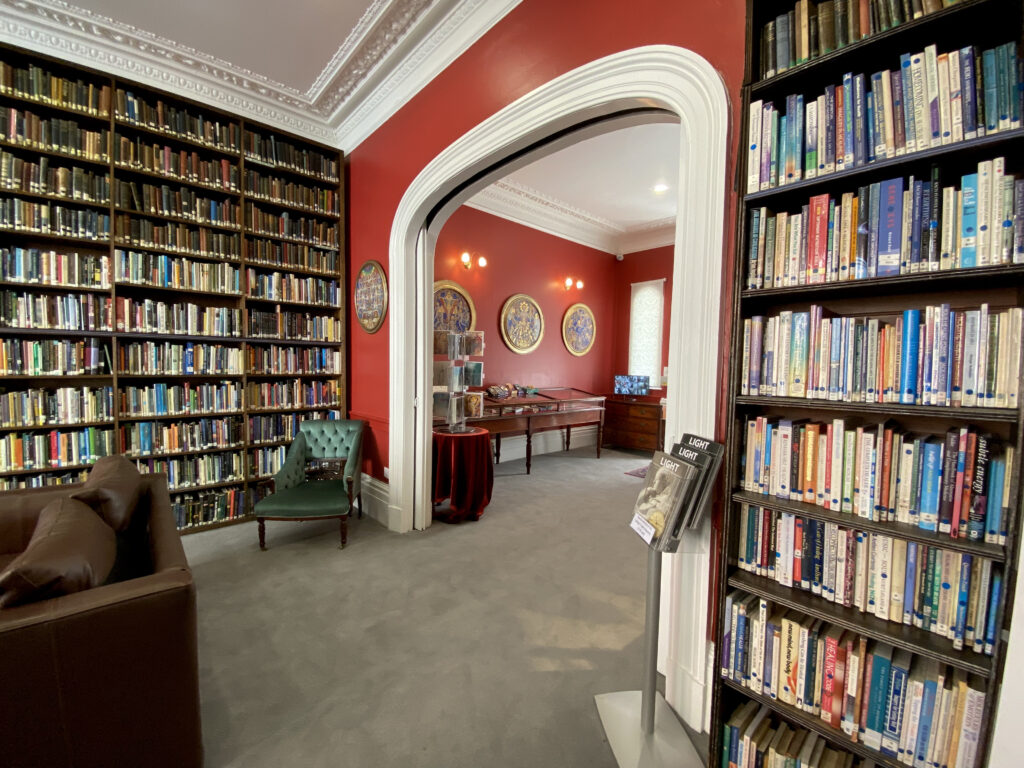
Gillian Matini, whose job title is “college principal,” and Vivienne Roberts, the institution’s curator and archivist, oversaw the renovation. During long lockdowns, they sorted through the College’s holdings, a big task that led to discoveries of books, documents, and art of whose existence these custodians of unusual relics from the past were not even aware. Now, their institution’s six-story Victorian townhouse has been sympathetically renovated, and its rooms refurnished with elegant, understated antique cabinets. As a well-informed Spiritualist might put it, the entire building has been “redialed” into a new spectrum of rejuvenating light and color.
Strange Things Among Us drew upon the College’s vast library and archive of material about Spiritualism and esoterica. While the exhibition was on view, the general public — not just the College’s enrolled students or guests who had paid to attend its lectures and special events — was afforded a rare opportunity to step inside the old building and savor its treasures. (Portions of the exhibition remain on view and are accessible to those with authorized access to the College; in its reception area, general visitors may find books and works of art on sale.)
For the purposes of the exhibition, each of the building’s rooms was named after the title of a book in the College’s collection; those names evoked the show’s central themes. “Light and Colour,” a room on the building’s uppermost floor, took its label from Babbitt’s book. As visitors made their way down to lower floors, they passed through “The UFO Enigma,” Twixt Two Worlds,” “Shadow Land,” and “A Goodly Company.” The building’s basement housed the “Land of Mist” — of course. Where else, in a venerable, old Victorian pile, would a land of mist be lodged?
During the renovation, these rooms were painted in harmonizing shades of subtle green-gray and soft lilac, which help generate a calm-feeling atmosphere — all the better for stopping to contemplate a wide range of thinkers and artists’ visions, and the auras, energies, and spirits they tapped into or that inspired them.

Artworks and objects related to a diversity of spiritual beliefs were presented alongside and in dialog with scientific theories and far-out automatic drawings associated with or that had been made by a variety of diviners from the past and the present. On display were drawings, paintings, or sculptural objects by such mediumistic, Spiritualist, or esoteric artists as Georgiana Houghton, Ethel le Rossignol, Madge Gill, Anna Howitt Watts, Arild Rosenkrantz, Alice Pery, Austin Osman Spare, Ionel Talpazan, Alma Rumball, Isabelle de Steiger, Heinrich Nüsslein, and Madge Donohoe.
Some of these artists’ names will be familiar to devotees of art brut and outsider art. Some are better known than others, but each one’s life story and complete oeuvre could become the subjects of an in-depth dissertation.
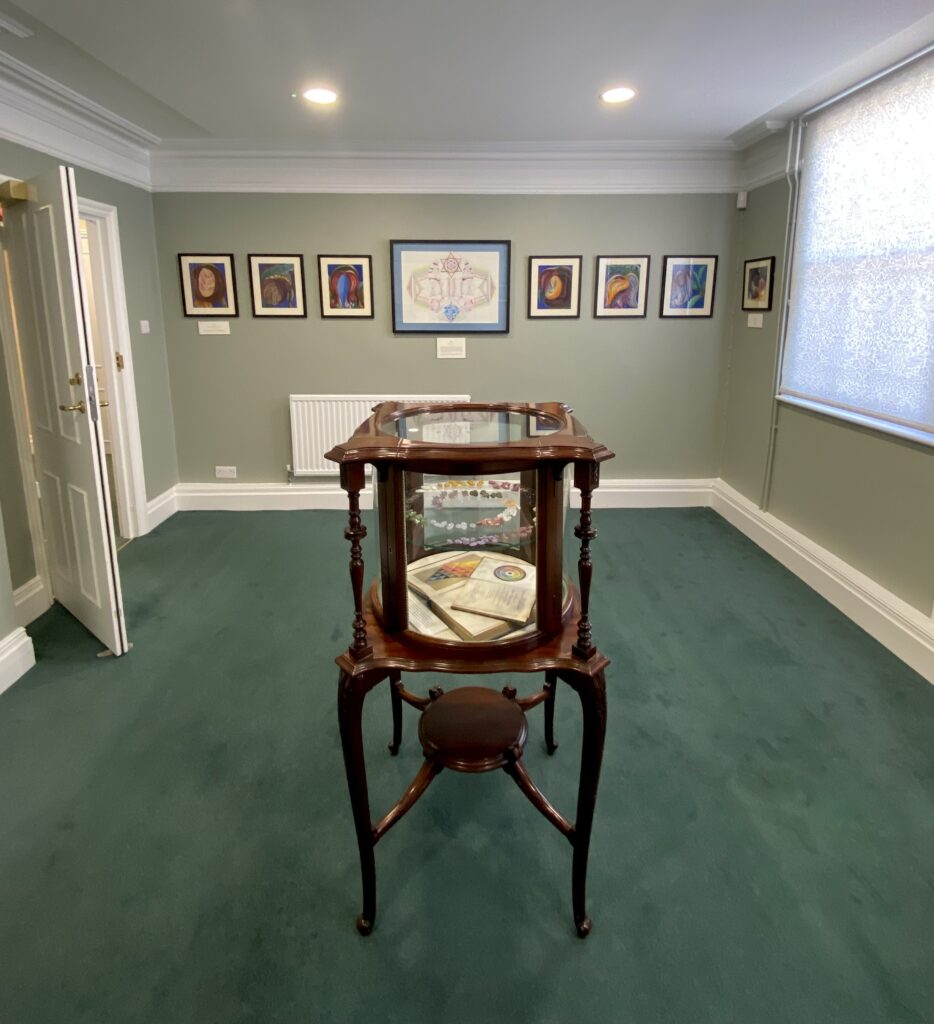
During my visit to the College to take in the delights of Strange Things Among Us, I spoke with Vivienne Roberts.
Cathy Ward for brutjournal: I believe you discovered a book in your library, and that the exhibition took its title from that volume.
Vivienne Roberts: Yes, Strange Things Among Us is a book of ghost stories written by Henry Spicer in 1863; we liked the idea of using a title from a book, so we stood in the library and started pulling out volumes. Gill Matini pulled that one out, and we both agreed that it was perfect. Also, using book titles [to name the renovated rooms] offered a way of introducing elements of the collection that we hadn’t really focused on before, such as the hauntings of Borley Rectory and UFOs. The College has a wonderful esoteric library, with more than 11,000 volumes, many of which are full of the incredible supernatural recollections and experiences of people through the ages.
CW: Didn’t you also discover some very old books from the 17th and 18th centuries?
VR: The earliest, from 1695, was displayed in the “Mysteries of Magic” room, where most of the others with it dated from the early 1700s, along with a first edition of Francis Barrett’s The Magus, from 1801. The library is amazing. Delve into any book, and there is a whole rabbit hole to go down. There are so many mediums and psychic researchers we’ve lost sight of; history has swallowed them up, so you can draw any of those books out and bring them back to life.
CW: Exactly who was collecting these books? Were they donated to the College when it was first established?
VR: The College was set up as the London Spiritualist Alliance in 1884 by William Stainton Moses, who was an Anglican priest, teacher, Oxford [University] scholar, and medium. He encouraged the 100 founding members to donate to the library. They gave books but they also donated artworks, and that’s how the collection began. We were fortunate that many of those members had been involved in Spiritualism for a long time and had given works to earlier societies such as the British National Association of Spiritualists, which became the Central Association of Spiritualists. When it ceased operating, the London Spiritualist Alliance was given its collection of books and artworks.

CW: Who made up the London Spiritualist Alliance’s 100 founding members? Did they include men and women?
VR: Of the 100 founding members, eight wished to remain anonymous, and of the 92 [others,] 42 were women. So women were always very much a part of it from the start and often held prominent positions on the [association’s governing] council. [The mediumistic artists] Georgiana Houghton, Anna Howitt and Barbara Honywood were all founding members — three really striking artists.
CW: They wouldn’t have been communicating together via “the table” — the séance table, that is. So, in an era long before telephones, e-mail, or text messaging, how would they have arranged to meet? Looking back, the fact that such like-minded people were gathering like this seems extraordinary.
VR: I like to think of the Victorians rushing around London in their fly carriages making their way to the next séance soirée. There were an abundance of home circles, in which séances were conducted regularly in the residences of Spiritualists. On top of that, you had public meeting places, where there would be lectures and demonstrations. If you were part of the Spiritualist community, you would read Light (the College’s publication), which was set up in 1881, and also Medium and Daybreak or The Spiritualist or Christian Spiritualist. All of these papers gave opportunities for mediums to advertise and they were filled with reports on the latest séances and Spiritualist developments.
CW: A lot is going on in the world today that could prompt a revival of interest in everything esoteric. Historically, this is interesting, because when Spiritualism first emerged, there was the Industrial Revolution, which dramatically altered rural life and probably damaged the human psyche. Now, in the digital age, our lives are profoundly affected by a technological revolution in ways that appear to be invisible, like an energy or a frequency pulsing through the atmosphere.

VR: I think you’re absolutely right. It’s a kind of engagement with something we don’t fully understand. With the Industrial Revolution and telegraphy, when people could first speak across countries, it was groundbreaking and mind-blowing. One of the transatlantic telegraph pioneers, Cromwell Varley, was a Spiritualist. With inventions like that, it was just a short leap to think, well, what other frequencies are out there? Often, they used that terminology in mediumship —— “tuning in,” like a radio.
We now talk of “energies,” and there must be other dimensions, absolutely. “Science and the Seers” was an important room in the exhibition, as it laid out the influences that created the perfect storm for the modern Spiritualist movement — the coming-together of scientific and mystical thought. It doesn’t surprise me at all that Spiritualism was so popular in the Victorian era and could appeal to anyone, regardless of [his or her] religion, class and gender. I’m also not surprised that we are seeing a resurgence of interest now.
CW: Strange Things Among Us and the renovation have reintroduced the public to what is happening here at the College of Psychic Studies. Until this recent exhibition, very few people outside of the College had ever seen anything from its archive, so working on that show must have been quite an experience for you.
VR: I come from an art background, so the history of Spiritualism presented a whole, new learning curve for me. I came across the College in 2012 when [I was] co-curating Madge Gill — Medium & Visionary, a retrospective exhibition at Orleans House Gallery [in Twickenham, to the southwest of central London]. The College was kind enough to lend some stunning artworks by [some] important artists. I was then invited by Gill Matini in 2016 to curate a show for the College on its archive, which is full of treasures. [Later, a] 2019 exhibition was slightly different, [for] we were looking more at the contemporary side, bringing in other artists and updating the collection.
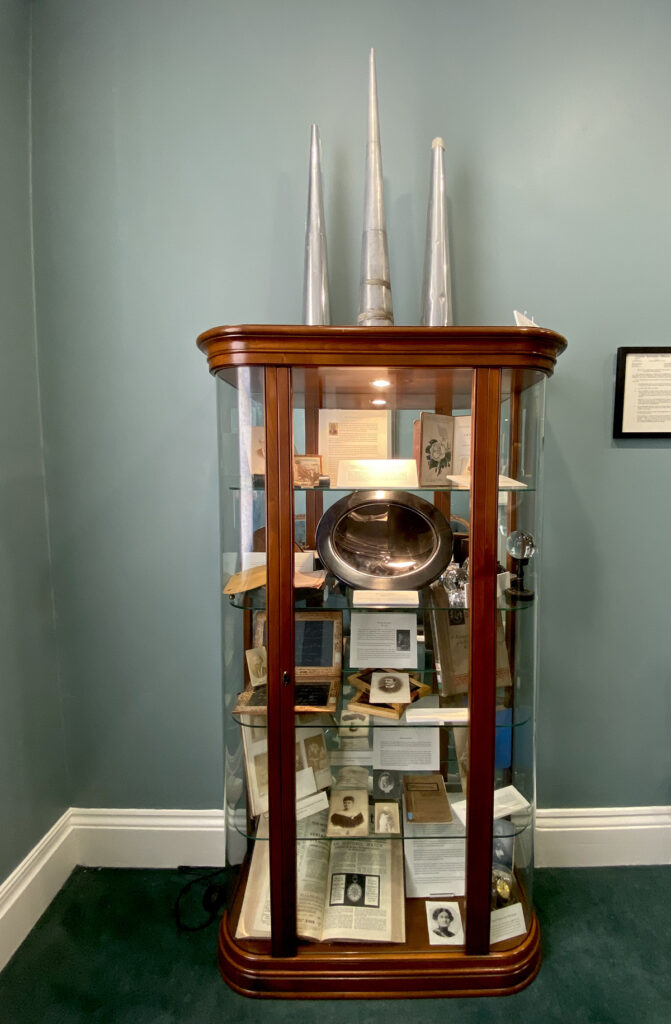
CW: Perhaps other artists who are interested in the subjects the College focuses on will emerge and come to your attention in years to come. That will happen only if they know that a place like this exists.
VR: Already, people are starting to come to us, [just as] they did a long long time ago. We wanted to reawaken that engagement [and] show that there is a place for spirit-inspired art that is alive and thriving.
CW: Beyond Europe and, to some degree, the United States, which, historically, have been the focus of the research of this kind of institution, there are the histories and traditions of spirit-based art and practices of other continents to explore, too. Africa, with its vast, complex, rich cultural-religious history related to the spirit world, and countries like Haiti…
VR: Yes, and Latin America, too. In many countries, Spiritualism is much more accepted. You don’t have to persuade people to believe in the supernatural; they grow up with it.
CW: You and Gill have made the College feel open to the world.
VR: I love that this building is an old Victorian townhouse in which Sir Arthur Conan Doyle wandered around in the 1920s, and that this room was used as a laboratory for psychical research. Before the renovation, you walked into the reception [area], which was dominated by 1970s furniture, and it didn’t work.
CW: You’ve regrounded this institution in its history — not heavy-handedly, but with a subtle touch. You’ve allowed the art to be seen beautifully on the walls. You’ve reframed some pieces in ways that are more in keeping with the eras in which they were created. Nothing is over the top; to the contrary, you did not take a more theatrical route, installing heavy drapes.
VR: Change can be hard, because energy has been built up in these rooms. The College tutors and mediums teach and work in these rooms, so we had to be mindful of that. The furniture is all second-hand and has exactly the right feel for the look we were going for. There is so much historical energy in each room. I wonder who sat round this table at a séance, or who enjoyed a glass of something in front of this fireplace, discussing ghost stories until late at night. Mysterious things happened here, and the building keeps those secrets.
Resources
The College of Psychic Studies
16 Queensbury Place
London SW7 2EB England
United Kingdom
Telephone: (44) 020-7589-3292
https://www.collegeofpsychicstudies.co.uk/



